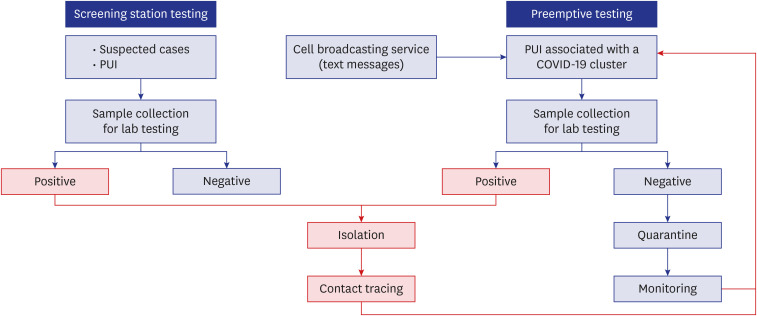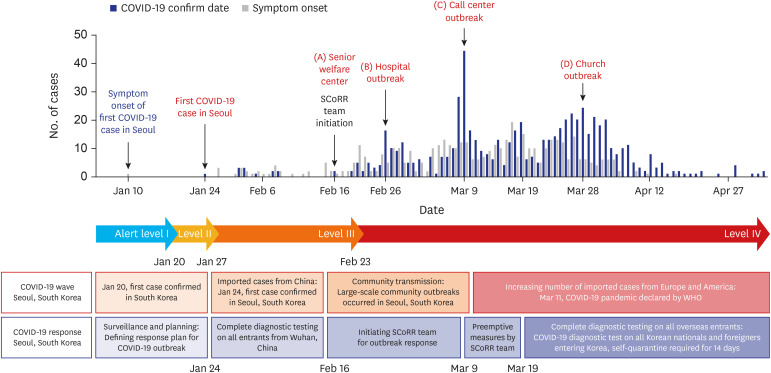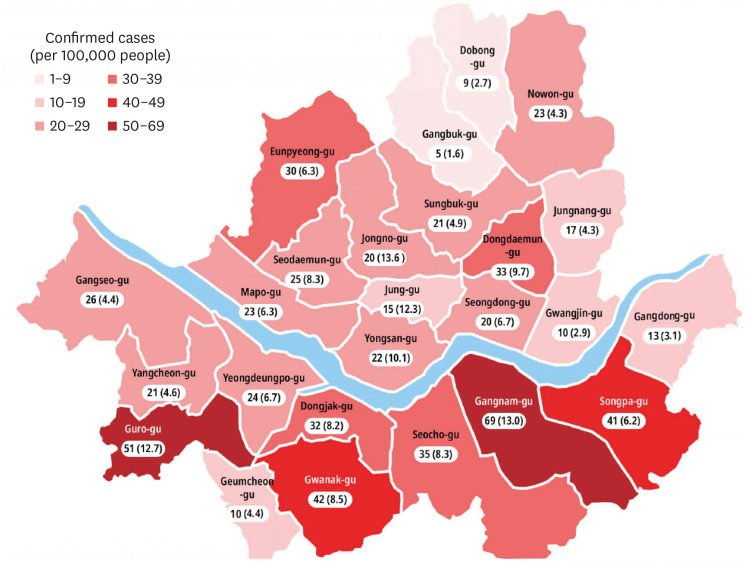Application of Testing-TracingTreatment Strategy in Response to the COVID-19 Outbreak in Seoul, Korea
- Affiliations
-
- 1Seoul Center for Infectious Disease Control and Prevention, Seoul, Korea
- 2Department of Internal Medicine, Seoul Metropolitan Government-Seoul National University Boramae Medical Center, Seoul, Korea
- 3Disease Control & Prevention Division, Seoul Metropolitan Government, Seoul, Korea
- 4Graduate School of Public Health, Seoul National University, Seoul, Korea
- 5Department of Urban Public Health, University of Seoul, Seoul, Korea
- 6HIRA Research Institute, Health Insurance Review & Assessment Service, Wonju, Korea
- 7Public Healthcare Center, Seoul National University Hospital, Seoul, Korea
- 8Department of Health Policy and Management, Seoul National University College of Medicine, Seoul, Korea
- KMID: 2508805
- DOI: http://doi.org/10.3346/jkms.2020.35.e396
Abstract
- Background
Following the coronavirus disease 2019 (COVID-19) outbreak in Wuhan, China, a total of 637 patients had been diagnosed with the disease in Seoul as of May 2, 2020. Our study aimed to describe the impact of the 3T strategies (preemptive testing, prompt tracing and proper treatment) on the epidemiological characteristics of COVID-19 in Seoul.
Methods
The descriptive and explanatory analysis was carried out on critical indicators such as epidemiological characteristics and key duration of patient status change from January 24 to May 2 in Seoul before and after preemptive testing for patients under investigation associated with COVID-19 clusters.
Results
Preemptive testing increased the positive test rate (3.9% to 4.2%), an asymptomatic case at diagnosis (16.9% to 30.6%), and reduced the time from symptom onset to quarantine (4.0 to 3.0 days). Prompt tracing decreased unknown sources of infection (6.9% to 2.8%), the mean number of contacts (32.2 to 23.6), and the time-varying reproduction number R(t) (1.3 to 0.6). With proper treatment, only 2 cases of mortality occurred, resulting in a fatality rate of just 0.3%.
Conclusion
In the first wave of the COVID-19 pandemic lasting 100 days, the effect of the 3T strategies flattened the curve and decreased the time during which infected individuals were contagious, thereby lowering the R(t) below 1 in Seoul.
Figure
Cited by 6 articles
-
Clinical Characteristics and Outcomes of COVID-19 Cohort Patients in Daegu Metropolitan City Outbreak in 2020
Shin-Woo Kim, Seung-Mee Kim, Yu Kyung Kim, Jong-yeon Kim, Yu-Mi Lee, Bong-Ok Kim, Suhyun Hwangbo, Taesung Park
J Korean Med Sci. 2020;36(1):e12. doi: 10.3346/jkms.2021.36.e12.Preparing for the Coronavirus Disease (COVID-19) Vaccination: Evidence, Plans, and Implications
Jaehun Jung
J Korean Med Sci. 2021;36(7):e59. doi: 10.3346/jkms.2021.36.e59.Clinical Characteristics of COVID-19: Risk Factors for Early Oxygen Requirement after Hospitalization
Hyeon Jeong Suh, Eunyoung Lee, Sang-Won Park
J Korean Med Sci. 2021;36(19):e139. doi: 10.3346/jkms.2021.36.e139.Coronavirus Disease 2019 Cases at Universities and Colleges in Seoul Metropolitan Area
Young June Choe, Yun-Kyung Kim,
J Korean Med Sci. 2021;36(45):e302. doi: 10.3346/jkms.2021.36.e302.Impact of COVID-19 on the care of acute appendicitis: a single-center experience in Korea
Chang Woo Kim, Suk-Hwan Lee
Ann Surg Treat Res. 2021;101(4):240-246. doi: 10.4174/astr.2021.101.4.240.Epidemiological Characteristics and Outcome of Myocarditis and Pericarditis Temporally Associated With BNT162b2 COVID-19 Vaccine in Adolescents: Korean National Surveillance
Bin Ahn, Seung Hwan Shin, Myung-Jae Hwang, HyoSug Choi, Sara Na, Sangshin Park, Jue Seong Lee, Young June Choe, Yoonsun Yoon, Kyoungsan Seo, Jong Hee Kim, Hyun Mi Kang
J Korean Med Sci. 2024;39(49):e317. doi: 10.3346/jkms.2024.39.e317.
Reference
-
1. Zhu N, Zhang D, Wang W, Li X, Yang B, Song J, et al. A novel coronavirus from patients with pneumonia in China, 2019. N Engl J Med. 2020; 382(8):727–733. PMID: 31978945.
Article2. World Health Organization. Coronavirus disease 2019 (COVID-19) situation report: 103. Updated May 2, 2020. Accessed June 17, 2020. https://www.who.int/docs/default-source/coronaviruse/situation-reports/20200502-covid-19-sitrep-103.pdf?sfvrsn=d95e76d8_6.3. Na BJ, Park Y, Huh IS, Kang CR, Lee J, Lee JY. Seventy-two hours, targeting time from first COVID-19 symptom onset to hospitalization. J Korean Med Sci. 2020; 35(20):e192. PMID: 32449328.
Article4. Central Disaster Management Headquarters. Central Disease Control Headquarters. Guidelines for the operation of COVID-19 screening clinics. Updated May 15, 2020. Accessed October 19, 2020. http://ncov.mohw.go.kr/en/guidelineList.do?brdId=18&brdGubun=181&dataGubun=&ncvContSeq=&contSeq=&board_id=&gubun=.5. Park S, Choi GJ, Ko H. Information technology–based tracing strategy in response to COVID-19 in South Korea—privacy controversies. JAMA. 2020; 323(21):2129–2130. PMID: 32324202.
Article6. Park SY, Kim YM, Yi S, Lee S, Na BJ, Kim CB, et al. Coronavirus disease outbreak in call center, South Korea. Emerg Infect Dis. 2020; 26(8):1666–1670. PMID: 32324530.
Article7. Zhang J, Litvinova M, Wang W, Wang Y, Deng X, Chen X, et al. Evolving epidemiology and transmission dynamics of coronavirus disease 2019 outside Hubei province, China: a descriptive and modelling study. Lancet Infect Dis. 2020; 20(7):793–802. PMID: 32247326.
Article8. Fang D, Pan S, Li Z, Yuan T, Jiang B, Gan D, et al. Large-scale public venues as medical emergency sites in disasters: lessons from COVID-19 and the use of Fangcang shelter hospitals in Wuhan, China. BMJ Glob Health. 2020; 5(6):e002815.
Article
- Full Text Links
- Actions
-
Cited
- CITED
-
- Close
- Share
- Similar articles
-
- Cardiovascular Imaging Asia in the Era of the COVID-19 Outbreak
- Food service industry in the era of COVID-19: trends and research implications
- Changes in Clinical Characteristics among Febrile Patients Visiting the Emergency Department before and after the COVID-19 Outbreak
- Experience at Department of Laboratory Medicine during the COVID-19 Outbreak in Daegu
- WHO International Health Regulations Emergency Committee for the COVID-19 outbreak




